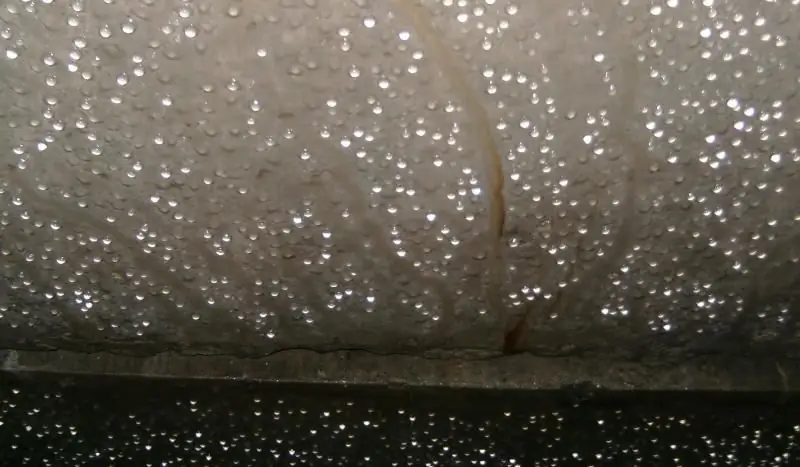
Table of contents:
- Author Bailey Albertson [email protected].
- Public 2023-12-17 12:53.
- Last modified 2025-06-01 07:32.
How to get rid of condensation and dampness in a cellar or basement

A damp basement or cellar in a home can cause many problems for owners. A high degree of humidity becomes not only the cause of food spoilage, but also the rapid destruction of the walls of the building. You can get rid of dampness on your own if you take the necessary measures.
Content
-
1 Dampness in the basement or cellar: reasons, optimal humidity level
- 1.1 Penetration of moisture outside
- 1.2 Internal source of moisture
- 1.3 Why is the basement of a wooden house damp
- 1.4 Why dampness occurs in the garage
- 1.5 What level of humidity is considered normal
-
2 How to remove dampness from the basement: effective methods of dealing
- 2.1 External waterproofing
-
2.2 Internal waterproofing device
- 2.2.1 Waterproofing the cement basement floor
- 2.2.2 Waterproofing the basement clay floor
- 2.2.3 How to remove basement dampness during precipitation season
- 2.2.4 How to strengthen a thin floor in a cellar
-
2.3 Ventilation system
- 2.3.1 Design of a simple supply and exhaust system
- 2.3.2 Video: ventilation device in the basement of the garage
-
3 Traditional methods of dealing with dampness
- 3.1 An environmentally friendly way to destroy fungus in the basement - video
- 3.2 How to eliminate dampness and fungus in a wooden cellar
- 4 How to prevent dampness: preventive measures
Dampness in the basement or cellar: reasons, optimal humidity level
Before you start removing dampness from a basement or cellar, you need to understand well the reasons for its occurrence. It can appear both in the basement of a brick, cinder-concrete, foam concrete or aerated concrete house, or in a wooden one.
Dampness from outside
Water can enter the basement from outside or appear as water droplets on the walls and ceiling.
- It seeps into the basement or cellar through microscopic cracks and defects in the walls, as well as due to poorly installed communication networks.
- If the basement is damp, then you need to pay attention to the condition of the blind area.
- Large trees growing near the foundation can let water into the room through their root system.
- The proximity to the surface of groundwater table can cause dampness.

The penetration of moisture from the outside of the house into the basement is possible due to poorly made blind area
Internal source of moisture
If condensation collects on the walls, then the ventilation system in the basement does not work well or is completely absent. To eliminate the cause, two pipes are enough to create supply and exhaust ventilation. In large basements, natural ventilation is usually insufficient, therefore it is necessary to create a forced system, thanks to which it will be possible to independently regulate the temperature in the room. If there are water pipes in the basement, they should be well insulated to prevent condensation on the walls and ceiling.

Dampness inside the basement appears due to poor ventilation of the room
Why is the basement of a wooden house damp
Since wood is a natural material, it is susceptible to various negative "diseases" - the appearance of mold and mildew, rotting. Therefore, dampness often appears in the basements of such buildings. If a pleasant microclimate reigns in the house, but greenish spots have appeared on the walls of the basement and an unpleasant smell of rot is felt, this indicates high humidity. To begin with, assess the state of the drainage and sewerage system. If there are no problems in this area, and the fungus does not disappear, it is necessary to look at the problem more broadly.
Poor waterproofing and insufficient ventilation can be the cause of high humidity levels. Fungus and mold will never grow in a dry and well-ventilated basement. The waterproofing layer will prevent moisture from entering the room, which contributes to the development of fungal and mold growths. Particular attention should be paid to old wooden buildings, which have long been damaged by the primary layer of waterproofing.
Why dampness occurs in the garage
This is a non-residential building that does not require capital insulation work. But many people have basements in garages, where they store various products and preserves. And in this case, dampness becomes a problem. As in an ordinary house, the garage must be well ventilated, waterproofed and have an external blind area.

The reason for the increase in humidity in the basement of the garage is temperature differences
What level of humidity is considered normal
For the human body, the normal humidity level is about 40-60%. At higher percentages, the risk of chronic respiratory diseases, skin diseases, and dangerous bronchial asthma increases. Dampness causes wet spots, mold, and a suffocating putrid odor. Wooden structures deteriorate, and stone and concrete structures begin to crumble. Metallic elements are covered with rust, while wooden ones quickly rot.
If it is impossible to remove dampness through natural ventilation, the humidity regime is disrupted in the house and fungal spores that are in the air begin to actively multiply not only inside residential premises, but also in basements (cellars). This process takes on a large scale. If the humidity level reaches 70% or more, and the air temperature in the room is 15 ° C, then active measures should be taken. First, you need to accurately determine the level of humidity using a hygrometer, and then proceed to identify the source of the dampness and eliminate the problem.

Normal humidity level in the basement up to 70%
How to remove dampness from a basement: effective methods of dealing
Cracks become a dangerous source of moisture seepage into the room. Therefore, the first thing to do is eliminate them.
-
We carefully examine the basement room and reveal large and small cracks. Sometimes it is necessary to dismantle the entire thermal insulation layer of the walls and ceiling, as well as remove the floor covering.

Cracks in the wall It is important to carefully inspect the basement for cracks and cracks, and then cover the identified defects with cement
- We carefully cover all defects with cement.
- We carry out work on the waterproofing device. They are internal and external.
External waterproofing
First, you should check the condition of the house outside, since very often dampness appears due to poor-quality installation of the drainage system.
- Examining the slopes on the building.
- We make sure that the downpipes drain water into a special rainwater funnel underground or into a surface gutter.
- Checking the drainage system around the house.
- We look at the condition of the blind area.
Any problems found must be eliminated.

A drain with a drainage system in the basement is a sure way to avoid dampness
Then you need to protect the walls underground.
-
We remove the destroyed blind area.

Destroyed blind area The destroyed blind area of the house needs to be removed
-
We dig a small hole outside the basement walls about 0.5 m wide and half a meter deep below the floor level.

A pit around the house for waterproofing from groundwater Dig a hole around the house half a meter wide to dry the walls
- Dry the outer walls of the house thoroughly. This can be done naturally or using special construction fans.
- We treat the walls with special antiseptics.
- We fill the hole with rubble.
-
We make a dense underground adjoining blind area from roofing material. To do this, we fix a sheet of material half a meter above the ground level on the wall of the house and take it over the edge of the outer wall.

Roofing material around the house Roofing material is laid around the house for waterproofing
-
We make a quality blind area.

New blind area around the house After drying the walls and laying the waterproofing material, make a new blind area around the house
- We coat it with bituminous mastic.
Internal waterproofing device
As a result of improperly made basement waterproofing, dampness begins to appear over time. To keep the room dry, this must be corrected.
- We dry well the basement.
-
We remove the old peeling coating from the walls, ceiling and floor.

Remove damaged plaster from the walls It is necessary to remove the plaster damaged by mold and fungus from the walls for a high-quality repair of all defects
- We clean all the cracks and cracks. We carefully seal the damaged areas with a cement mortar.
-
We saturate all walls with an effective agent against fungus and mold.

Concrete cleaner A special tool is used to clean concrete surfaces from fungus and mold.
- Bituminous mastic (or other waterproofing agent) thoroughly coat all walls, ceiling and floor.
-
We close up the leaks and, where they were earlier, with alabaster.

Coat the basement walls with mastic The device for internal waterproofing of the basement is performed by treating the walls with water-repellent materials
-
For greater efficiency, you can re-plaster the basement walls.

Plastered basement walls After drying and waterproofing, you can also re-plaster the basement walls.
Several actions will help to enhance the waterproofing effect.
-
To make the renovated walls more resistant to water, brickwork must be laid in the basement, which will move about 3 centimeters away from the old walls.

New brickwork walls New brickwork of basement walls will increase their resistance to moisture
-
So that the exhaust air from the basement can freely flow out into the ventilation system of the old walls outside, it is necessary to make ventilation shafts in the new walls.

Basement ventilation Ventilation shafts are also made in new walls.
Basement cement floor waterproofing
- Dismantle the old floor.
- Seal all existing cracks and cracks in concrete with cement mortar.
-
When everything is dry, cover the floor with sifted sand or fine expanded clay (layer at least 5 cm).

Expanded clay layer on the floor After repairing cracks and crevices, a layer of expanded clay is poured onto the floor
-
Lay sheets of roofing material, 3 mm thick, with an overlap of 10 cm on top of each other and on the walls. You can use a special waterproofing film for the floor.

Waterproofing roofing material on the basement floor Roofing material sheets are laid with an overlap on each other and on the walls
-
Re-seal all the cracks with bitumen mastic and make a new screed.

Floor screed with cement mortar After laying the roofing material, perform a cement screed floor in the basement
- If you wish, you can lay logs and arrange a wooden floor.
Basement clay floor waterproofing
If the basement floor is made of clay, this will speed up the process.
- Remove a small layer of clay (5 cm).
- Align the base.
-
We lay polyethylene on top in 2 layers with an overlap of 10 cm on each other and on the walls.

Polyethylene on the basement floor For waterproofing the clay floor, polyethylene is laid on the surface
- On top of the film, pour a layer of slightly moistened clay with sawdust (10-15 cm thick) and tamp it well. We take sawdust and clay in a ratio of 1:10.
-
As it dries, the clay will crack a little, so the cracks will need to be repaired with the same solution.

Clay cracking on the floor Clay floor cracks as it dries
-
Then we put another layer of the same clay with a 20-25 cm approach to the walls.

Laying the second layer of clay After the first layer of clay has dried, the second is laid on the basement floor
- When the clay dries up, the humidity in the cellar will decrease, and the air will be much drier.
How to remove basement dampness during precipitation season
It often happens that humidity increases in autumn and spring during the high rainfall season. In this case, a different method of moisture removal is used.
-
We fill the floor with sand or gravel, about 10 cm thick. If the moisture does not go away, add more. This will reduce the level of groundwater to the point where the water cannot rise above the floor.

Cover the basement floor with sand To stop the flow of groundwater into the basement, its floor is covered with sand or gravel
-
To remove condensation from the walls, it is necessary to use a special waterproofing plaster solution, which will allow the walls and floor in the cellar to "breathe". You can buy a ready-made mixture (Monolith, Ceresit, Polimin, Consolit) or make it yourself. To do this, you need to mix hydraulic additives and dry plaster: for example, 250 ml of Cemaplast superplasticizer and 50 kg of cement or 21 g of Palmix per 50 kg of dry cement.

Tsemaplast Superplasticizer Cemaplast is used for the preparation of waterproofing plaster
How to reinforce a thin cellar floor
A thin floor causes dampness in the cellar. In this case, it is necessary to make a double base by laying sheets of roofing material, which will protect the floor from the appearance of excess moisture. All joints must be well coated with bituminous mastic, and then a fine cement screed must be made on top.
Ventilation system
Poor ventilation is one of the main causes of dampness in the basements of brick or wood houses.
The device of a simple supply and exhaust system
-
Take two thick pipes, one of which should be drawn from the basement floor and brought out under the ceiling to the street approximately 30 cm high. The pipe should not reach the floor by about 10 cm. This will be a supply system.

Basement supply pipe The supply pipe in the basement should not reach the floor by about 10 cm
- Place the second pipe directly under the ceiling and also bring it out to the street by about 40-60 cm. This will be an exhaust system.
-
The pipes should be at opposite ends of the room. Install special covers on their ends, which will protect the holes from rain and melt water entering them.

Supply and exhaust ventilation of the basement Supply and exhaust ventilation in the basement is carried out using two pipes
Video: ventilation device in the basement of the garage
Traditional methods of dealing with dampness
There are inexpensive but effective folk methods for dealing with dampness in basements.
-
To remove moisture, it is necessary to place four jars of white moss powder on the floor or shelves in the corners of the room. It perfectly absorbs moisture. This method will be effective only with a small percentage of basement moisture.

White moss White moss absorbs moisture well
-
You can remove moisture with hydrochloric acid. To do this, we remove all food and preservation from the basement. We dilute the acid so that a weak solution is obtained (100 ml for 1 liter of water). We put on gloves and carefully process the walls, shelves, ceiling and floor with the resulting solution. Be careful, as hydrochloric acid can cause chemical burns.

Hydrochloric acid Hydrochloric acid is used to remove moisture in the basement
-
Another method is also effective. Put a glass or ceramic deep dish on the floor, fill it with rock salt, and pour sulfuric acid on top. It is necessary to work only in protective clothing in compliance with all safety measures. The vapors that will be released as a result of a chemical reaction can destroy mold and fungal spores. When the moisture is gone, it is necessary to ventilate the room well and rinse all surfaces. You can buy sulfuric acid in chemical reagents online stores. This is a very dangerous substance, so you should think carefully about the advisability of using it in the basement of a residential building, so as not to endanger the people living in it.

Sulfuric acid tanks Sulfuric acid is also used to remove moisture in the basement.
-
After creating a ventilation system, you can use slaked lime to further remove excess moisture. To do this, you just need to put a deep container with the substance in the corner of the basement. It not only absorbs moisture, but also kills developing fungi in pairs.

Slaked lime Slaked lime absorbs moisture well and kills fungus
- If the walls in the basement are damp, but fungi and mold have not yet begun to appear, you can put hot clay bricks in different places (3-4 pcs. For a small room). As it cools, the clay will begin to actively absorb moisture. When the bricks have cooled down, they must be reheated.
- You can put an electric fireplace near a damp wall. It will warm up the required area and dry it. But this method will be effective only if a small section of the wall is damp in the basement.
- Mold and mildew in the basement can be removed with boric acid, acetic acid, or citric acid. You just need to wash all surfaces well with one of the active substances.
-
You can remove dampness from the cellar using ordinary diesel fuel. In this case, it is important to first free the room from food, and only then well fuel the walls and ceiling, whitewash the surfaces.

Diesel fuel is poured onto a concrete slab Diesel fuel is used to combat dampness in the basement room
Dampness in the basement of a garage or a wooden house can occur due to the proximity of groundwater, the location of the building in the lowland. Wooden structures are most susceptible to rotting due to the high level of humidity, therefore, methods for eliminating the cause must be effective, and folk are not always like that.
An eco-friendly way to destroy fungus in the basement - video
How to eliminate dampness and fungus in a wooden cellar
- We remove all wooden structures (shelves, racks, boxes) from the room.
- We wash off the mold and mildew with a solution of soda and soap and water.
-
Dry thoroughly and disinfect. To do this, add 100 g of copper sulfate to an aqueous solution of lime or clay (8-10 l) and process all the wooden elements, as well as the earthen floor of the cellar itself.

Copper sulfate Copper sulfate is used in folk recipes to eliminate fungus in the cellar
- We dry the cellar well. If this cannot be done in a natural way, then we use various heating devices - a heat gun, fireplace, electric heaters. Depending on the choice of the appliance and the degree of humidity, drying can take from two days to several weeks with interruptions for airing.
You can also remove mold from wooden surfaces with a solution of sodium fluoride, zinc-chlorine, sodium silicofluoride or ammonium.
- Dilute 30 g of the selected substance in hot water.
- Grout all wooden structures.

Ammonium Sulfate Powder removes mold from wooden cellar walls
You can make a special paste.
- We take 150 g of sodium fluoride, 135 clay and 200 ml of water.
- Add a chemical to boiling water and add clay.
- Mix everything well until a homogeneous consistency is formed.
- We process all surfaces of the cellar with the resulting paste and leave them to dry. This amount of paste is enough to process 1 m 2 of a wooden wall section. For greater efficiency, we carry out repeated processing in a month.

Sodium fluorosilicate powder is necessary for the preparation of a paste used to protect wooden structures from moisture
How to prevent dampness: preventive measures
- If you live in an old house and cracks regularly appear in the basement, which cause dampness, then you need to seal them well with rags soaked in bituminous mastic, and cover them with plaster on top. This will be a temporary method, but will prevent water from entering the room.
- In the basement, you can make a pit, which is a metal or concrete "glass" for water drainage. It will be possible to easily pump out water from it with a pump. But in this case, the floor in the room should have a slight slope towards the pit.
- It is necessary to regularly monitor the condition of the basement, check the condition of the sewerage and water supply systems, as well as the roof of the house.
- It is important to regularly ventilate the room.
- In summer, on hot days, take all wooden shelves and racks outside so that they dry out and warm up well in the sun.
- Treat walls every season with effective antiseptic agents.
Depending on how damp the walls and other surfaces of the basement are, as well as the cause of such a problem, it is necessary to choose the means to solve it. By using the various moisture removal methods correctly, you can always keep your basement or cellar clean and dry.
Recommended:
Shoes Creak When Walking: What To Do To Get Rid Of It, Why It Happens + Photos And Videos

Information about why shoes start to squeak when walking. What to do in such cases and how to get rid of the squeak once and for all
How To Get Rid Of Rats In A Private House, Chicken Coop, Apartment And Other Premises - Using Various Methods To Get Rid Of Rodents

Reasons for the appearance of rats in the house. What methods, means to use in the fight against rats in various residential and non-residential premises. Preventive actions. Video
How To Get Rid Of Humidity And Dampness In An Apartment Or House, As Well As From The Accompanying Smell, How To Eliminate It And Useful Tips

Dampness and fungus in an apartment and a private house. The reasons for the appearance of excessive moisture, condensation, mold and how to eliminate them. Preventive measures. Instructions
Why Condensation Forms On The Toilet Cistern And How To Get Rid Of It + Video

Causes of condensation in the bathroom, in particular on the toilet cistern. Detailed description of ways to eliminate condensation
5 Things I Will Get Rid Of Before The New Year To Bring Happiness And Wealth Into The House, As Well As Get Rid Of Negativity

According to the old tradition, before the New Year, I get rid of 5 unnecessary things in order to let the positive energy of happiness and prosperity into my life
